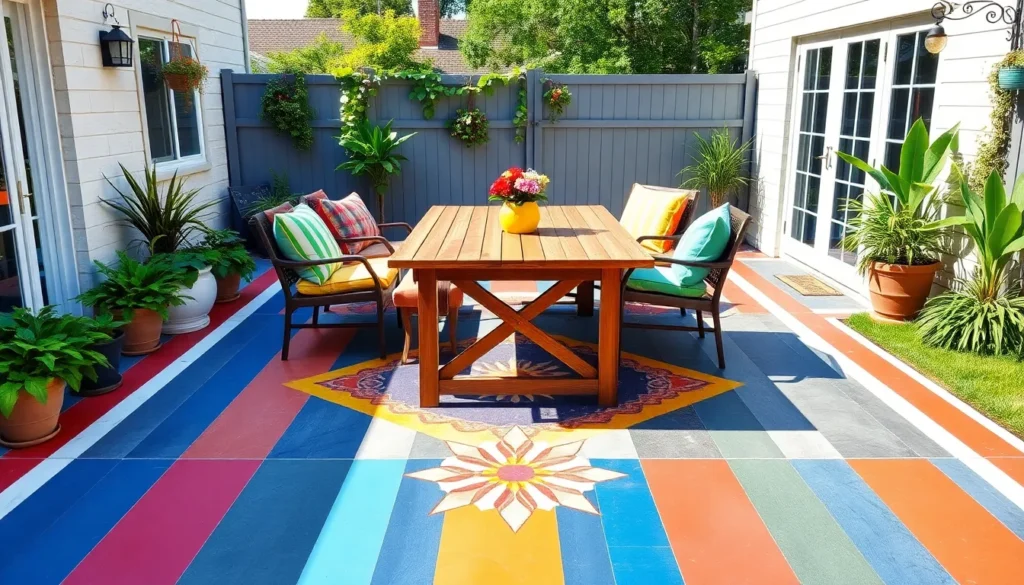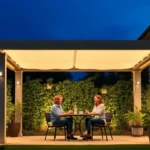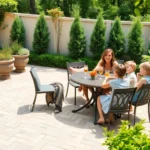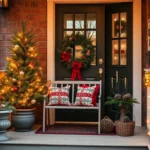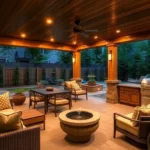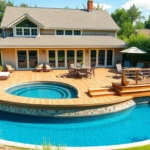Your concrete patio doesn’t have to look like a boring gray slab anymore. We’ve discovered that with the right paint ideas and techniques, you can transform your outdoor space into a stunning extension of your home that rivals expensive stone or tile installations.
Painting concrete patios has become one of the most cost-effective ways to boost curb appeal and create an inviting outdoor entertaining area. Whether you’re dreaming of a Mediterranean-inspired terracotta finish or a sleek modern geometric pattern, we’ll show you how achievable these transformations really are.
From choosing the right type of concrete paint to exploring creative color combinations and decorative techniques, we’ve compiled the most inspiring ideas that’ll make your neighbors wonder if you hired a professional contractor. Let’s jump into these game-changing concrete patio paint ideas that’ll completely revolutionize your outdoor living space.
Choose the Right Paint Type for Your Concrete Patio
Selecting the appropriate paint type determines your concrete patio’s durability and visual appeal. We’ll explore three main categories of concrete patio paints to help you make an well-informed choice.
Acrylic Concrete Paint Options
Acrylic concrete paint offers exceptional versatility for outdoor concrete surfaces. These water-based formulations provide excellent UV resistance, preventing color fading from sun exposure over multiple seasons. We recommend acrylic paints for their quick drying time of 2-4 hours and easy cleanup with soap and water.
Temperature flexibility makes acrylic paint ideal for climates with seasonal changes. Most acrylic concrete paints withstand temperatures from -20°F to 180°F without cracking or peeling. Popular brands like BEHR Premium and Sherwin-Williams offer concrete-exact acrylic formulas that include built-in primers.
Application becomes straightforward with acrylic paints since they require minimal surface preparation. We suggest choosing 100% acrylic formulations over acrylic blends for maximum longevity. These paints typically last 3-5 years with proper maintenance and surface preparation.
Epoxy-Based Paint Answers
Epoxy concrete paint delivers superior durability and chemical resistance for high-traffic patios. These two-part systems create an extremely hard surface that resists stains from oil, grease, and common patio spills. We find epoxy paints particularly beneficial for pool decks and outdoor kitchen areas.
Adhesion strength sets epoxy apart from other concrete paint types. Professional-grade epoxy systems can achieve bond strengths exceeding 400 psi when properly applied to clean concrete surfaces. Brands like Rust-Oleum EpoxyShield and Quikrete Epoxy Garage Floor Coating offer consumer-friendly options.
Curing time requires patience since epoxy paints need 24-72 hours for full hardness development. We recommend applying epoxy during mild weather conditions with temperatures between 60-85°F and low humidity. These paints can last 7-10 years with proper application and minimal maintenance.
Latex Paint Considerations
Latex concrete paint provides a budget-friendly option for decorative concrete patio projects. These paints offer good breathability, allowing moisture vapor to escape from the concrete substrate. We typically recommend latex paints for covered patios or areas with minimal foot traffic.
Flexibility becomes a key advantage of latex formulations in freeze-thaw climates. Standard latex concrete paints expand and contract with temperature changes without developing cracks. But, durability limitations mean these paints usually require reapplication every 2-3 years.
Surface preparation requirements remain minimal for latex paint application. We suggest using latex paints with built-in bonding agents for better adhesion to concrete surfaces. Premium latex options from Benjamin Moore and Valspar include mildew-resistant additives perfect for humid climates.
Prepare Your Concrete Surface Properly
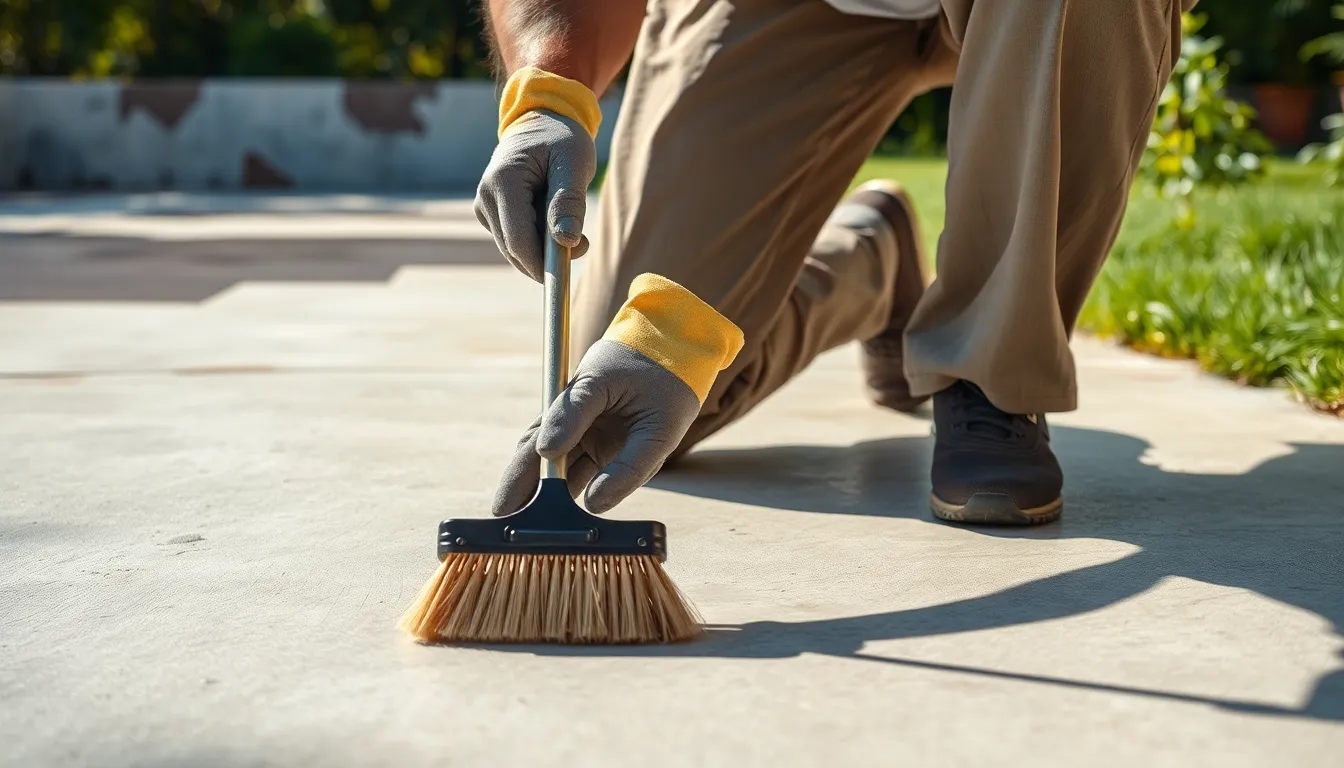
Proper surface preparation determines the success of your concrete patio painting project. We can’t stress enough how this critical step affects paint adhesion and the longevity of your finished patio.
Clean and Degrease the Patio
Start with a thorough cleaning to remove all dirt, grease, and stubborn stains from your concrete surface. We recommend using a degreaser or mild detergent solution for the most effective results.
Scrub the entire patio surface with a stiff brush to work the cleaning solution into the concrete pores. Pay special attention to areas with oil stains, food spills, or heavy foot traffic that may have accumulated grime.
Rinse thoroughly with clean water after scrubbing to remove all cleaning residue and loosened debris. Allow the patio to dry completely before moving to the next step, as moisture trapped beneath paint can cause peeling and adhesion problems.
Repair Cracks and Surface Damage
Inspect your patio carefully for cracks, chips, or other surface imperfections that could affect the final paint appearance. Even small damage can become more noticeable once paint is applied.
Fill all cracks and holes using a concrete patching compound designed for outdoor use. Work the compound into cracks with a putty knife, ensuring it’s level with the surrounding surface.
Smooth out repaired areas and remove excess compound to create an even surface. Let all repairs dry according to the manufacturer’s instructions, which typically ranges from 24 to 48 hours depending on weather conditions.
Apply Primer for Better Adhesion
Choose a concrete primer specifically recommended for paint projects to ensure optimal adhesion and a longer lasting finish. We’ve found that quality primers create the essential bond between concrete and paint.
Apply primer evenly across the entire patio surface using a roller or brush, following the manufacturer’s coverage recommendations. Some specialty concrete paints don’t require primer, so always check product labels before starting.
Allow primer to cure completely before applying your chosen concrete paint. This step creates the foundation for professional looking results that will withstand weather and foot traffic for years to come.
Create Bold Solid Color Transformations
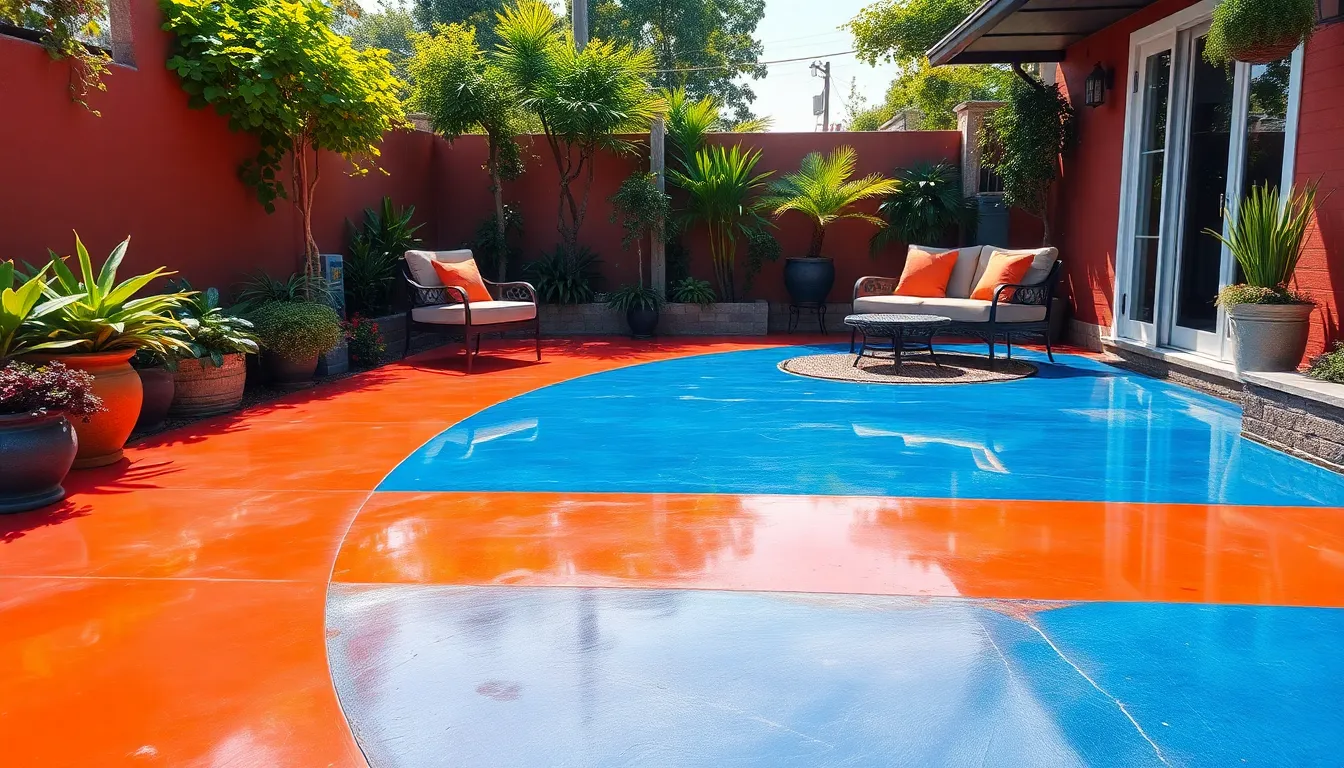
Now that we’ve prepared our concrete patio surface properly, we can transform it with bold solid colors that create stunning focal points. Solid color applications offer the most dramatic impact for your outdoor space renovation.
Classic Neutral Tones
Neutral colors provide timeless elegance that complements any outdoor furniture style. Gray and charcoal shades create sophisticated backdrops that blend seamlessly with contemporary and rustic design elements. Beige tones offer versatility while maintaining a clean, polished appearance that enhances your patio’s overall aesthetic.
We recommend using high-quality concrete paint in these neutral shades to achieve professional results. These colors work exceptionally well as base coats if you plan to add decorative borders or geometric patterns later. Neutral tones also reflect less heat than darker colors, making your patio more comfortable during summer months.
Vibrant Statement Colors
Bold, vibrant colors transform ordinary patios into extraordinary outdoor living spaces. Terracotta creates warm, inviting atmospheres that make guests feel welcome and comfortable. Bright blues and vivid greens serve as eye-catching statement pieces that reflect your personal style and creativity.
High-gloss finishes in vibrant colors enhance the visual impact while providing superior durability. White concrete paint brightens the entire area, making spaces feel larger and more open while offering excellent protection against weather damage. These bold choices work best when you want your patio to become the centerpiece of your outdoor design.
Earth-Tone Inspirations
Earth tones connect your patio naturally with surrounding landscapes and garden elements. Olive green harmonizes beautifully with plant life, creating seamless transitions between hardscape and softscape areas. Terracotta and warm beige shades evoke rustic charm while maintaining sophisticated appeal.
These natural color choices help patios blend into outdoor environments without losing their distinct character. Earth tones work particularly well for Southwestern or Mediterranean design themes, contributing to cozy and grounded outdoor living experiences. We find these colors age gracefully, maintaining their beauty even as they develop subtle weathering patterns over time.
Design Eye-Catching Geometric Patterns
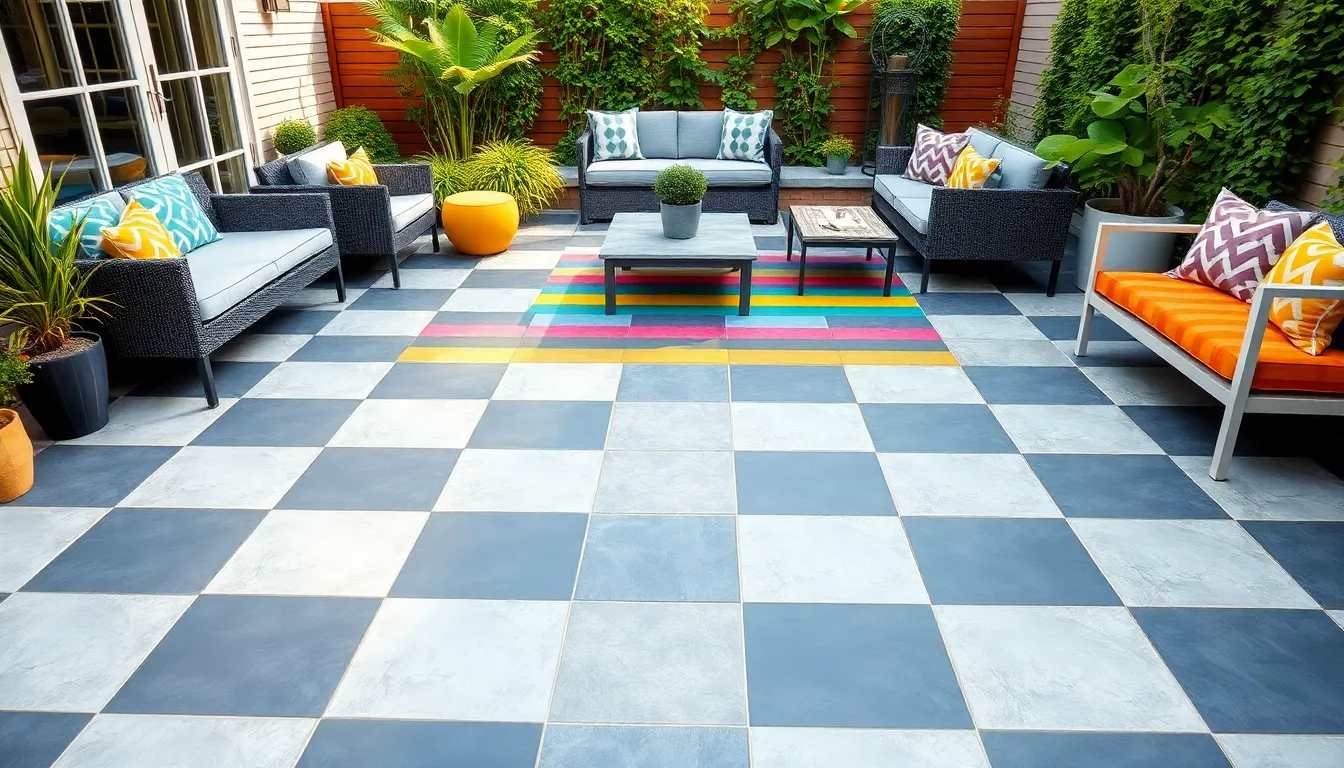
Geometric patterns transform ordinary concrete patios into striking focal points that combine modern aesthetics with timeless appeal. We’ll explore three distinctive geometric approaches that deliver maximum visual impact through strategic paint application.
Checkerboard and Diamond Designs
Checkerboard patterns instantly elevate concrete patios with their classic sophistication and proven versatility. We recommend starting with subtle gray shades that create timeless style while maintaining elegant restraint across your outdoor space. Diamond motifs offer similar visual dynamics but add movement that makes patios appear larger and more expansive than their actual dimensions.
These traditional designs work exceptionally well with neutral color palettes that provide sophisticated backdrops for outdoor furniture and landscaping. Subtle gray combinations create depth without overwhelming the space, while maintaining the refined aesthetic that complements various architectural styles. Both patterns require minimal stenciling expertise yet deliver professional results that enhance your patio’s overall design coherence.
Stripe and Linear Patterns
Bold stripes create immediate visual impact through their simple execution and striking geometric presence. We suggest thick white and gray stripe combinations that offer clean, graphic elements perfect for DIY beginners seeking dramatic transformation. These linear designs require basic painter’s tape application but produce sophisticated results that rival professional installations.
Vibrant stripe variations in sherbet or rainbow hues bring joyful energy to outdoor entertaining areas. Colorful linear patterns work particularly well in contemporary settings where playful design elements complement modern outdoor furniture. Simple stripe applications remain manageable for weekend projects while delivering the visual punch that makes patios memorable gathering spaces.
Hexagon and Triangle Motifs
Hexagon patterns leverage modern geometric principles to create visually complex surfaces that appear professionally designed. We achieve sharp, clean lines through strategic stencil placement and quality painter’s tape that ensures precise edge definition. Triangle motifs similarly capitalize on contemporary design trends while offering endless combination possibilities for personalized patio aesthetics.
Layering different geometric shapes creates custom patterns that maintain cohesive themes across larger patio surfaces. Combined hexagon and triangle applications allow creative expression while preserving the structured appearance that defines successful geometric patio designs. These advanced patterns require more planning but produce stunning results that showcase sophisticated design sensibilities through strategic paint application.
Add Texture with Specialized Paint Techniques
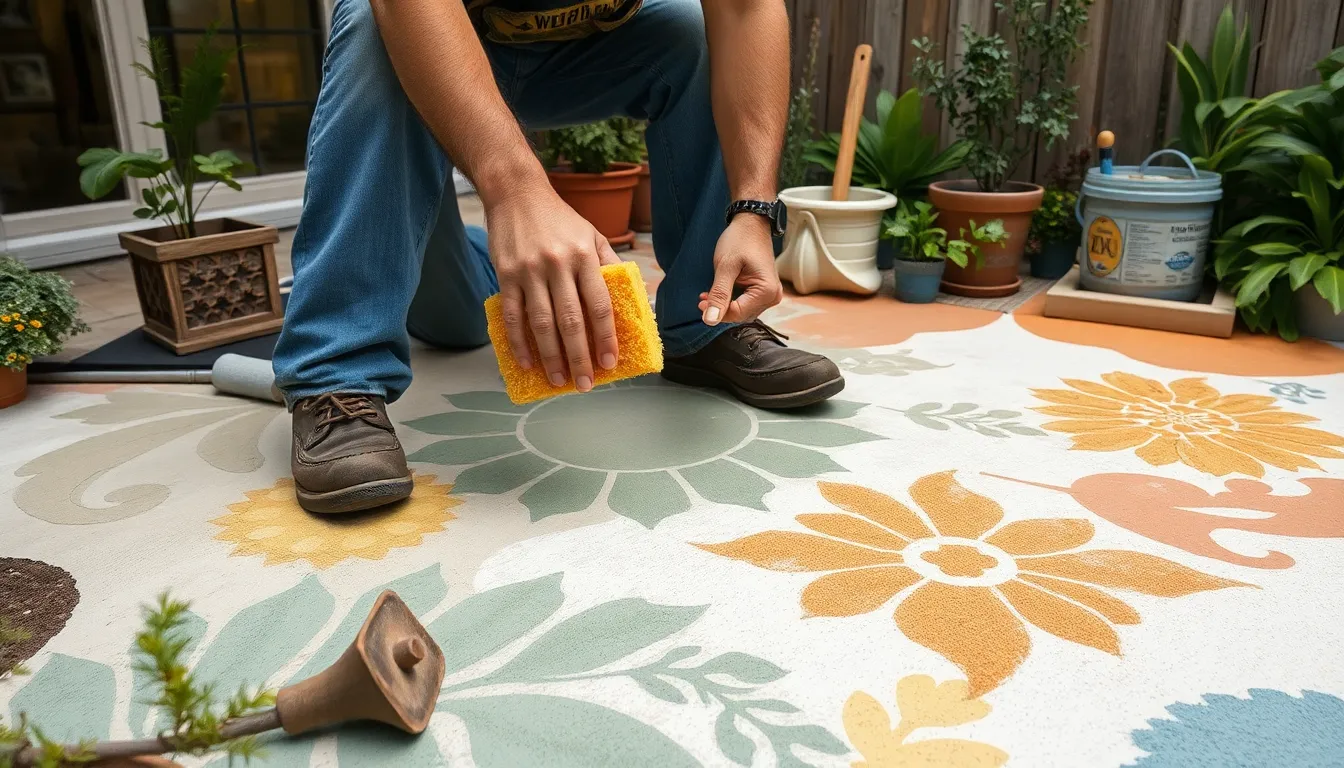
Beyond flat color applications, we can transform ordinary concrete surfaces using texture-focused painting methods that create depth and visual interest. These specialized techniques offer practical ways to enhance both the appearance and functionality of concrete patios.
Sponge Painting Effects
Sponge painting creates mottled textures that simulate natural stone or weathered surfaces on concrete patios. We achieve this effect by dabbing a damp sponge into paint and gently pressing it onto the base coat, creating organic patterns that add character and depth.
Different sponge types produce varying results when applying this technique. Natural sea sponges create irregular, flowing patterns that mimic aged stone, while synthetic sponges offer more uniform textures suitable for contemporary designs.
Layering multiple colors enhances the realistic appearance of sponge-painted surfaces. We recommend starting with a neutral base coat, then applying darker accent colors through sponge dabbing to create shadows and dimension that replicate natural stone variations.
Stenciled Texture Applications
Stenciling offers precise pattern control for creating tile-like appearances or geometric designs on concrete patios. We apply patterned templates over dried base coats, then paint through the openings to achieve repeatable, professional-looking textures.
Template materials determine the final texture quality of stenciled applications. Plastic stencils work well for simple geometric patterns, while laser-cut templates provide intricate border designs that transform plain concrete slabs into visually striking focal points.
Color contrasts maximize the impact of stenciled texture work. We suggest using lighter colors for raised pattern areas and darker tones for recessed sections, creating three-dimensional visual effects that enhance the patio’s overall design coherence.
Brush Stroke Texturing Methods
Brush stroke techniques create handcrafted finishes that add tactile appeal while the paint remains wet. We vary our brushing patterns through crosshatching or directional strokes to influence how light interacts with the painted surface.
Different brush types produce distinct texturing results when applied to concrete surfaces. Stiff-bristled brushes create pronounced linear textures ideal for slip-resistant surfaces, while softer brushes generate subtle patterns that maintain decorative appeal.
Directional brushing patterns enhance visual flow across the patio space. We recommend maintaining consistent stroke directions within defined areas while varying patterns between sections to create zones that guide foot traffic and define entertaining spaces.
Incorporate Decorative Stencil Designs
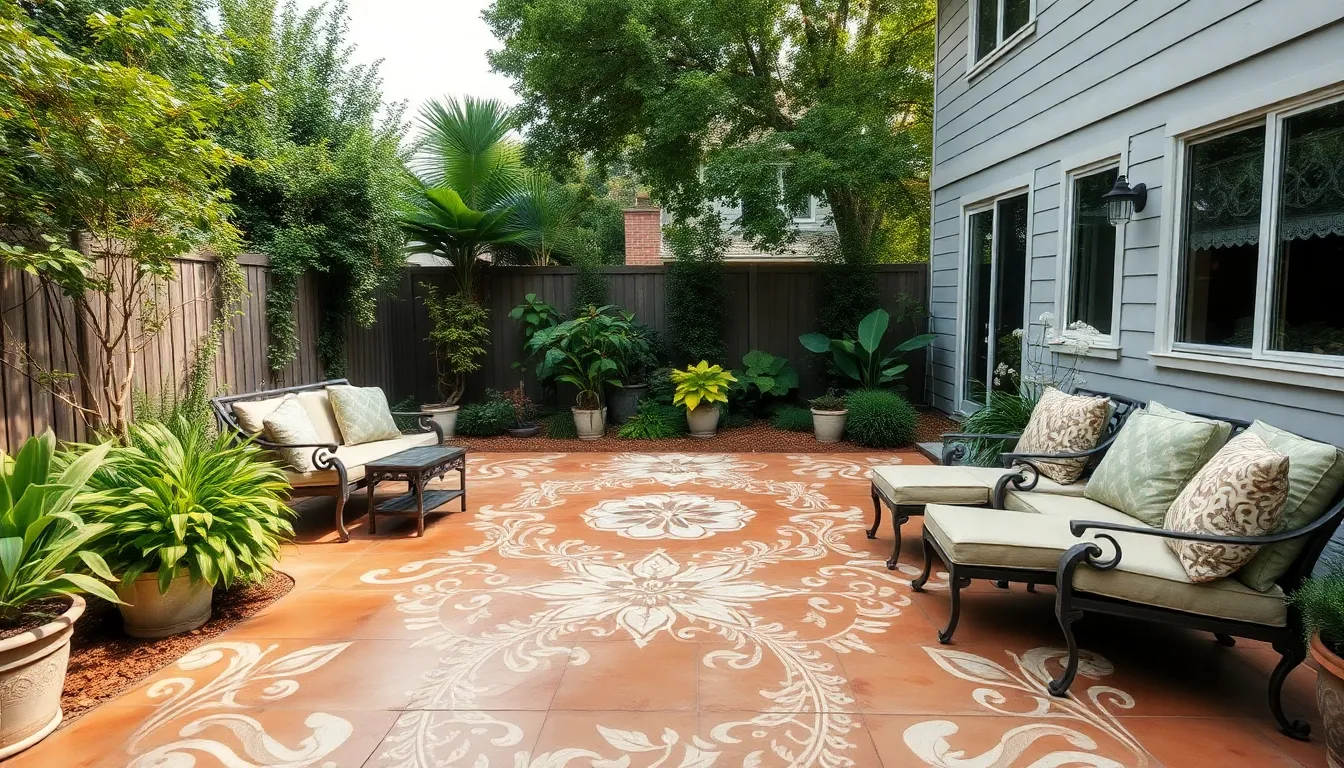
Stenciling offers a sophisticated way to transform your concrete patio with artistic patterns and motifs. We’ll explore three popular stencil categories that can elevate your outdoor space from ordinary to extraordinary.
Floral and Nature Motifs
Nature-inspired stencils bring organic beauty to concrete surfaces through leaves, vines, flowers, and branches. These designs create a tranquil garden atmosphere that’s perfect for outdoor relaxation spaces. We recommend using soft earthy colors or contrasting shades to make floral patterns stand out beautifully against your concrete base.
Leaf patterns work exceptionally well along patio borders, while vine motifs can gracefully flow across larger surface areas. Branch designs add vertical interest when stenciled near seating areas or garden transitions. The organic shapes soften the hard lines of concrete, creating a more inviting outdoor environment.
Color selection plays a crucial role in nature motif success. Earth tones like sage green, warm browns, and muted yellows complement floral designs naturally. Bold contrasts using deep forest greens against light concrete backgrounds create striking visual impact.
Moroccan and Mediterranean Patterns
Moroccan stencils feature intricate geometric shapes, repeating tessellations, and exotic flair that transform patios into culturally rich retreats. Stars, latticework, and arabesques are common motifs that add sophisticated international style to outdoor spaces. These patterns work particularly well in entertainment areas where you want to create memorable gathering spots.
Mediterranean designs emphasize warm, inviting patterns that complement outdoor dining and relaxation. Tessellated patterns create continuous visual flow across large patio surfaces. We suggest using earth tones like terracotta, olive green, and warm beige to enhance the authentic Mediterranean ambiance.
Application techniques for these complex patterns require careful planning and positioning. Start with corner motifs to establish proper alignment, then work systematically across the surface. The intricate nature of these designs makes them ideal focal points rather than full-surface treatments.
Modern Abstract Stencils
Contemporary abstract patterns use geometric shapes, lines, and minimalistic designs to create sleek artistic statements. These stencils pair perfectly with modern furniture and contemporary décor styles. Clean lines and bold shapes offer sophisticated backdrops that balance visual interest with functional simplicity.
Geometric precision defines modern abstract stenciling, using circles, triangles, and angular patterns to create structured visual appeal. We recommend shades of gray, charcoal, and black as base or accent colors for abstract designs. These neutral tones create sophisticated foundations that won’t compete with outdoor furniture or landscaping.
Scale considerations matter significantly with abstract patterns. Large-scale geometric shapes work well on expansive patios, while smaller repeated patterns suit intimate seating areas. The minimalistic approach allows these designs to complement rather than overwhelm your outdoor living space.
Apply Faux Finishing Techniques
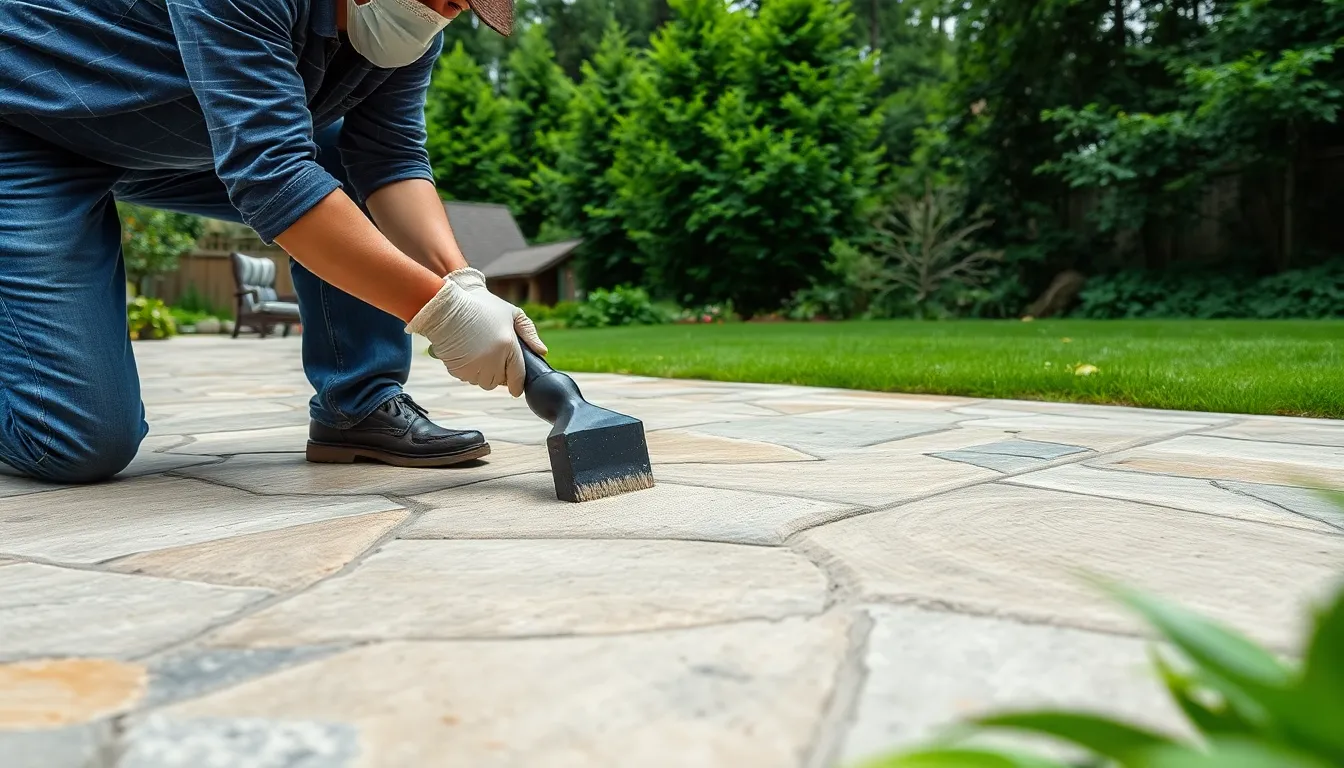
Faux finishing techniques transform ordinary concrete patios into stunning surfaces that mimic expensive natural materials. We’ll explore three popular approaches that create authentic appearances without the high costs or maintenance requirements of genuine stone, wood, or marble.
Stone and Brick Imitations
Vertical overlays create the foundation for realistic stone and brick appearances. Applying a concrete overlay to patio surfaces allows us to hand carve, stamp, and stain the material for authentic textures. We can achieve the uneven surfaces and color variations that characterize natural stone and brickwork through careful carving techniques.
Stenciling methods produce precise tile and brick patterns. Using adhesive stencils or painter’s tape, we create grid systems that define individual stone or brick sections. The process involves taping off grout lines, painting them with primer colors, then filling tile sections with contrasting hues for realistic depth.
Sponging and ragging techniques add natural color variation. We apply multiple concrete stains using rags, sponges, or brushes to create the variegated coloring found in authentic stone surfaces. These layering methods produce the weathered appearance that makes faux finishes indistinguishable from natural materials.
Wood Grain Effects
Board forming creates authentic wood textures on concrete surfaces. This specialized technique uses molds and stamping tools to impress realistic wood grain patterns directly into the concrete overlay. We achieve the raised grain lines and natural wood characteristics that make patios appear crafted from genuine lumber.
Color washing enhances the wood grain illusion. After texturing, we apply color washes in wood tones like honey oak, weathered cedar, or rich mahogany. Multiple translucent layers build depth and replicate the natural aging process that occurs in real wood surfaces.
Weather resistance makes faux wood superior to natural materials. Unlike genuine wood decking, our concrete wood grain effects resist warping, splitting, and insect damage while maintaining their appearance for years. This durability makes them ideal for outdoor patio applications where maintenance concerns matter.
Marble and Granite Looks
Layered staining creates marble’s distinctive veining patterns. We use sponges and feathers to apply different colored stains in organic flowing patterns that mimic natural marble veining. Starting with base colors, we build complexity through multiple applications of complementary and contrasting tones.
Granite effects require speckled and mottled techniques. Using spattering methods and sponge applications, we create the varied spots and mineral inclusions characteristic of granite surfaces. Multiple translucent layers add the depth and complexity that makes these finishes appear genuine.
Blending techniques ensure seamless color transitions. We work quickly with wet stains to blend edges and create smooth color gradations. This prevents harsh lines that would reveal the artificial nature of the finish, maintaining the organic appearance of natural stone surfaces.
Use Color-Washing and Ombre Effects
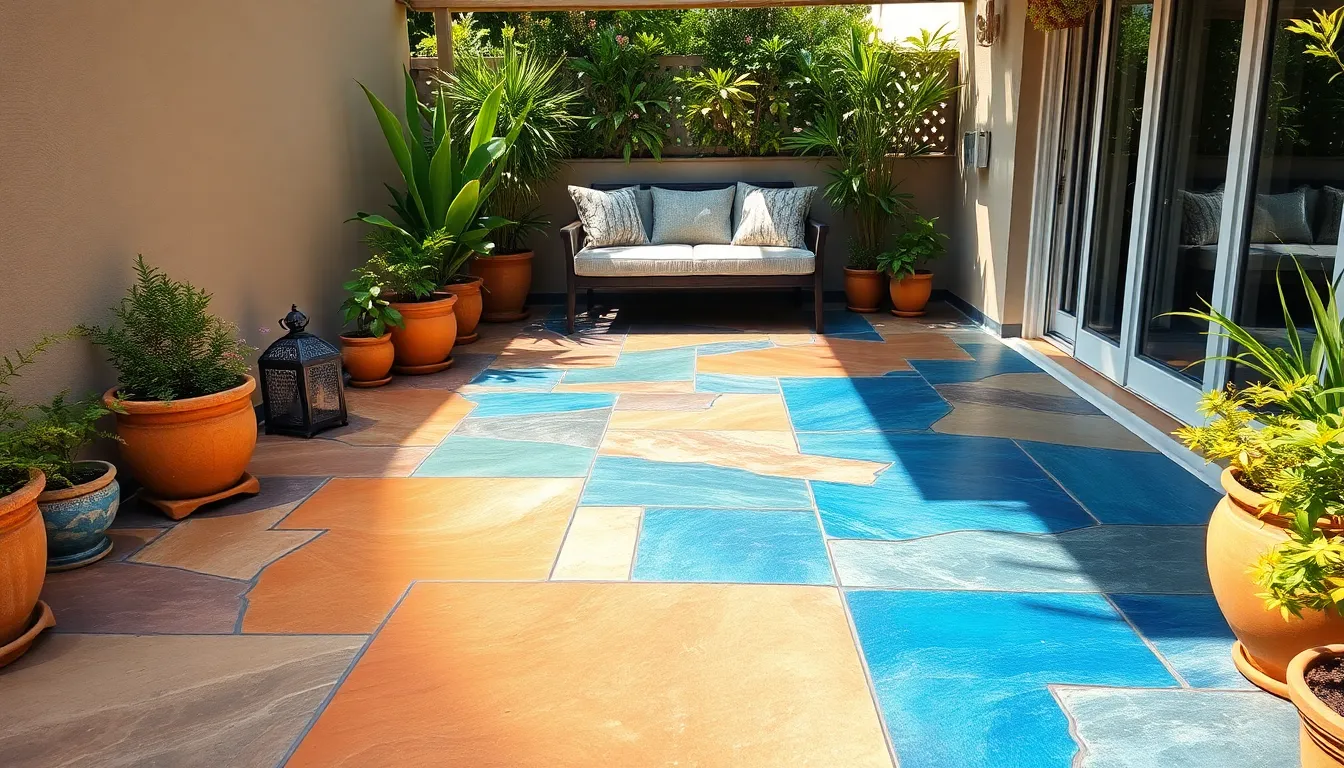
We can achieve sophisticated color depth through advanced blending techniques that transform basic concrete into visually stunning surfaces. These methods create seamless transitions and artistic effects that elevate our patio beyond traditional solid color applications.
Gradient Color Transitions
Gradient color transitions blend two or more colors progressively across our patio surface, creating smooth visual movement that mimics natural elements. We’ll start by applying our lightest color as the base coat, then gradually introduce darker shades while the paint remains wet. Cool blues transitioning to grays evoke coastal stone appearances, while warm tans flowing into reds create desert sandstone effects.
The technique works best when we customize the gradient direction to complement our patio’s shape and size. Horizontal gradients make narrow spaces appear wider, while vertical transitions add height to compact areas. Radial gradients create focal points that draw attention to exact patio zones like seating areas or fire pit surroundings.
Layered Color Techniques
Layered color techniques involve applying multiple thin paint coats to build depth and protect our concrete surface simultaneously. We begin with a solid base coat in our chosen foundation color, allowing it to dry completely before adding subsequent layers. Each additional layer uses translucent washes or stippled applications with brushes, rags, or natural sponges.
This approach allows us to combine solid colors with transparent washes for unique finishes that change appearance throughout the day. The multiple paint layers create superior concrete protection by sealing the surface under several coats. We can experiment with overlapping patterns or geometric shapes in each layer to develop custom designs that reflect our personal style.
Blended Shade Applications
Blended shade applications mix multiple paint colors directly on our patio surface while wet, using brushes or rollers to softly blur boundaries between different hues. This technique requires working quickly in manageable sections to prevent harsh lines from forming as the paint begins to set. We’ll achieve the best results by maintaining consistent pressure and overlapping our brush strokes to ensure smooth color flow.
The blending process creates organic effects that simulate natural stone weathering or artistic abstract patterns. We can vary our blending intensity to create subtle color variations or bold artistic statements depending on our design goals. Working in small sections ensures we maintain control over the color transitions and avoid unwanted paint drying before we complete the blending process.
Create Border and Accent Designs
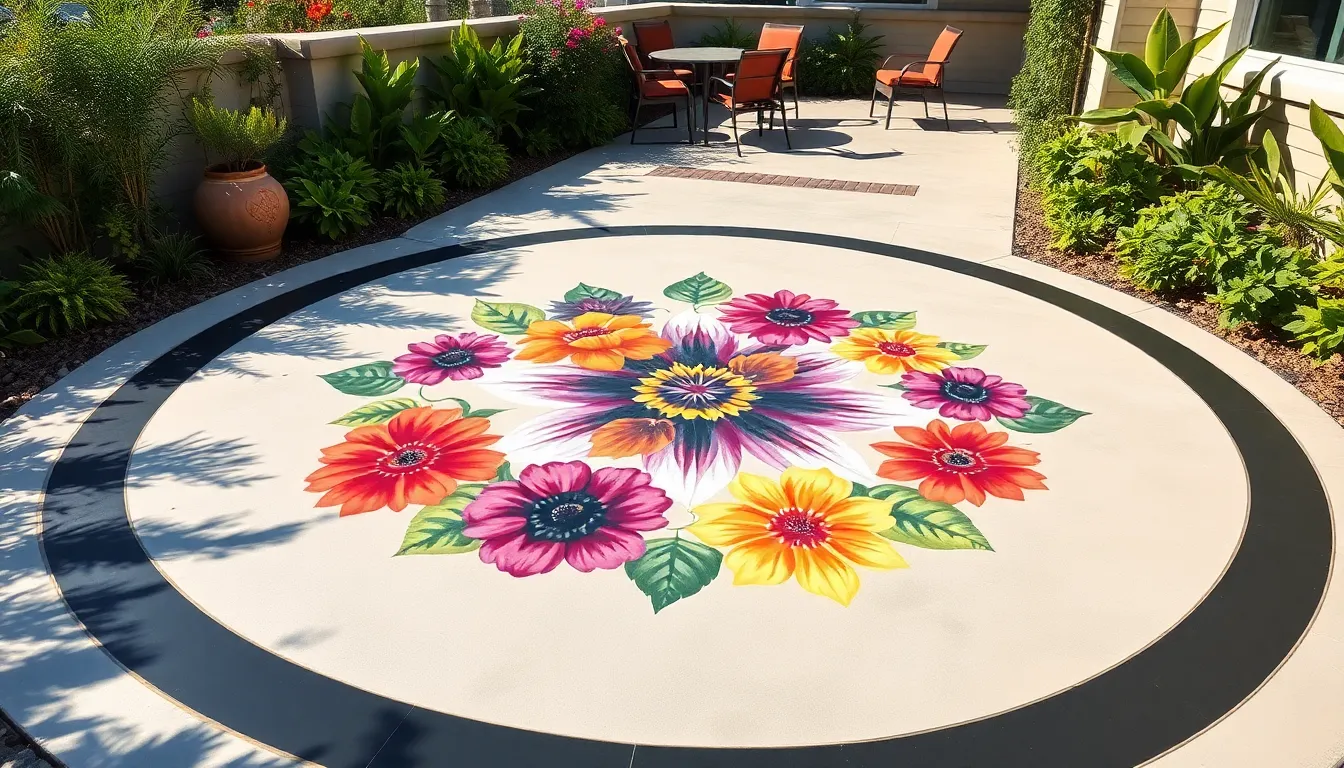
Concrete patio borders and accent features transform basic outdoor spaces into sophisticated design statements. We’ll show you how strategic paint placement creates visual interest while maintaining practical functionality.
Perimeter Border Ideas
Perimeter borders define your patio space and enhance its overall visual appeal through strategic color placement. Contrasting colors along the patio’s edge create instant definition, with classic options including white, gray, or black frames that provide timeless elegance. Bold homeowners often choose vivid hues like deep blues or terracotta shades for playful, eye-catching effects that complement their industry design.
Geometric patterns elevate simple border concepts into modern design features. Striped borders add dimension and contemporary flair, while alternating color blocks create rhythm around the patio’s perimeter. We recommend using painter’s tape to achieve crisp, professional lines that maintain clean edges throughout your border design.
Multiple border widths offer different visual impacts depending on your patio size. Narrow 4-inch borders work well for smaller patios, while wider 8-12 inch borders provide dramatic framing for larger outdoor spaces. Coordinating your border color with existing exterior elements like shutters or trim creates cohesive design flow between your home and outdoor living areas.
Central Medallion Features
Central medallions serve as stunning focal points that draw attention and elevate your patio’s aesthetic appeal. Designers frequently use stencils to create detailed patterns in the patio’s center, with star motifs, oversized flowers, and classic tile designs ranking among the most popular choices. These medallions anchor the space visually while providing conversation starters for outdoor entertaining.
Stenciled medallions offer precision and complexity that freehand painting cannot match. Quarter-sized medallions work perfectly for intimate patios measuring 10×10 feet, while larger installations benefit from medallions spanning 4-6 feet in diameter. We suggest selecting medallion colors that complement your perimeter border while providing enough contrast to ensure visibility from all patio angles.
Layered medallion designs create depth and sophisticated visual interest. Base colors establish the medallion’s foundation, while accent colors highlight exact pattern elements like petals, geometric shapes, or decorative flourishes. This technique transforms simple concrete surfaces into artistic outdoor canvases that rival expensive tile installations at a fraction of the cost.
Corner Accent Elements
Corner accents add sophistication without overwhelming your patio’s overall design scheme. Quarter-circle arcs painted in complementary colors create gentle transitions between patio sections, while herringbone patterns introduce textural interest that mimics expensive brick or stone installations. Mosaic-inspired touches using multiple coordinating colors bring artistic flair to previously unused corner spaces.
Strategic corner placement enhances your patio’s design coherence while addressing awkward transitional areas. Painted corners can complement larger border designs or central medallions, creating unified outdoor spaces that feel intentionally designed rather than randomly decorated. We find that corner elements work particularly well when they echo colors or patterns used elsewhere in your patio design.
DIY-friendly corner techniques require minimal specialized tools while delivering professional-looking results. Painter’s tape creates clean geometric shapes, while foam brushes enable smooth color application in tight corner spaces. Small stencils designed specifically for corner applications eliminate guesswork and ensure consistent results across all four patio corners, making this an accessible project for weekend DIY enthusiasts.
Consider Weather-Resistant Paint Formulas
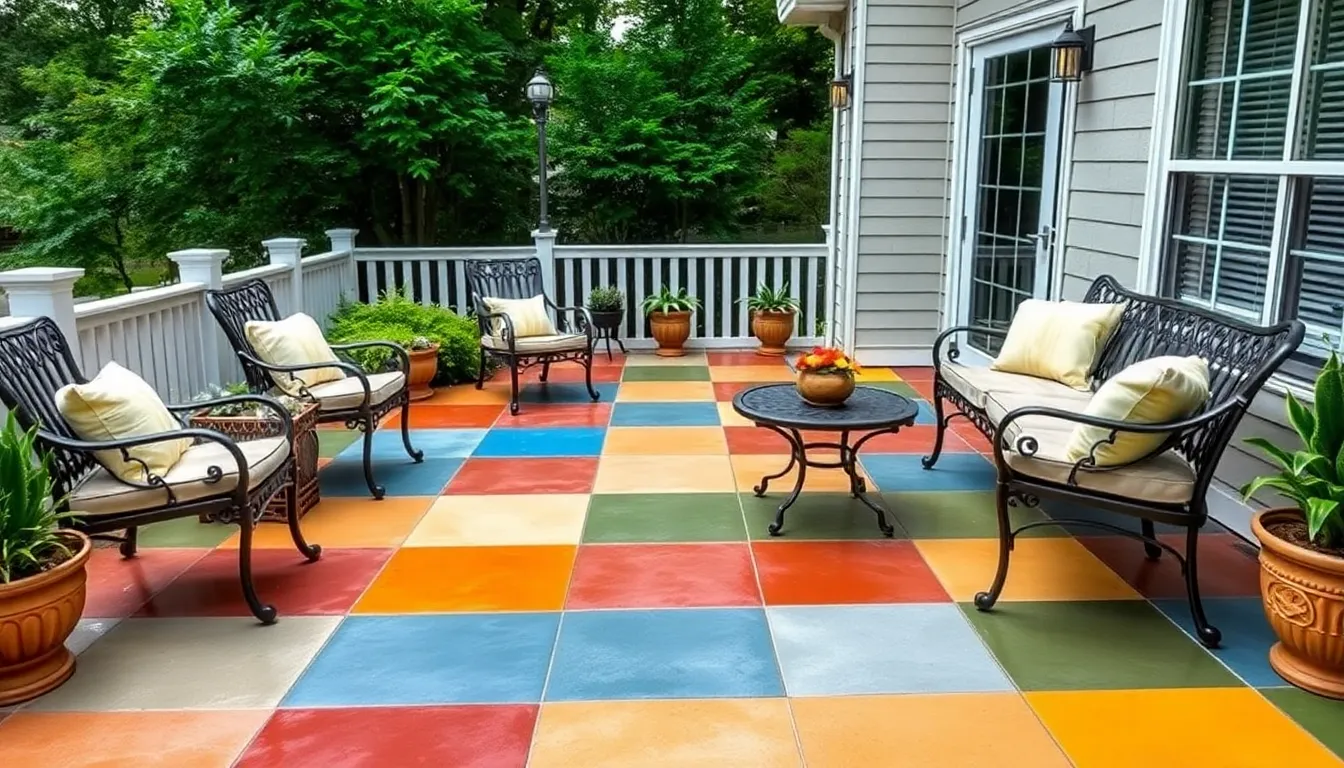
Selecting the right paint formula ensures your concrete patio withstands harsh outdoor conditions while maintaining its beautiful appearance for years. Weather resistant properties become crucial when transforming your outdoor space into a durable entertaining area.
UV-Protected Paint Options
Outdoor concrete paints with UV inhibitors prevent fading and discoloration from constant sun exposure. Acrylic latex paints designed for exterior use commonly resist fading while maintaining vibrant colors under direct sunlight. We recommend looking for paints specifically labeled for exterior concrete that mention UV protection or colorfastness ratings.
These specialized formulations protect your investment by maintaining color integrity throughout seasons of intense sunlight. UV resistant paints typically include advanced polymer technology that creates a protective barrier against harmful rays. Quality exterior concrete paints often feature enhanced color retention properties that keep your patio looking fresh and vibrant.
Moisture-Resistant Coatings
Concrete’s porous nature makes moisture resistance absolutely critical for long lasting results. Waterproof or moisture resistant coatings protect against stains, acid rain, and water related deterioration that can destroy your beautiful paint job. Polyurethane based deck coatings can be applied over concrete paint to create superior waterproof protection.
Some acrylic latex paints and epoxy coatings offer excellent resistance to moisture penetration on their own. These formulations help prevent cracking and peeling caused by water intrusion into the concrete surface. Moisture resistant properties become especially important in areas with frequent rain or high humidity levels.
Temperature-Stable Formulations
Concrete naturally expands and contracts with temperature changes, requiring flexible paint formulas that accommodate this movement. Acrylic latex paints excel at flexing without chipping or peeling, making them ideal for outdoor concrete surfaces exposed to temperature fluctuations. These formulations maintain their integrity through freeze thaw cycles and extreme heat conditions.
Epoxy based paints offer superior hardness and chemical resistance but work best on stable surfaces with minimal temperature movement. Temperature stable formulations prevent the cracking and adhesion failures that plague inferior paint products. We find that choosing paints specifically formulated for exterior concrete guarantees optimal temperature stability and weather resistance performance.
Conclusion
We’ve explored countless ways to transform your concrete patio from ordinary to extraordinary through strategic paint choices and creative techniques. From bold geometric patterns to sophisticated faux finishes that mimic natural stone and wood these methods offer endless possibilities for customization.
The key to success lies in proper preparation and selecting weather-resistant formulas that’ll withstand the elements. Whether you’re drawn to subtle earth tones or vibrant statement colors your painted patio will become a stunning focal point that enhances your outdoor living space.
With these techniques and ideas you’re equipped to create a beautiful durable surface that reflects your personal style while adding important value to your home. Your neighbors will definitely be asking for your secrets!
Frequently Asked Questions
What type of paint is best for concrete patios?
The best paints for concrete patios are acrylic, epoxy-based, and latex formulations. Acrylic paints offer good durability and color retention, epoxy-based paints provide superior adhesion and chemical resistance, while latex paints are easy to apply and clean up. Choose weather-resistant formulas with UV protection and moisture resistance for optimal longevity in outdoor conditions.
How do I prepare my concrete patio before painting?
Proper preparation involves three essential steps: thorough cleaning to remove dirt, grease, and stains; repairing any cracks or surface damage with concrete patching compound; and applying a concrete primer to ensure optimal paint adhesion. This preparation is crucial for achieving professional-looking results and ensuring the paint’s longevity.
What are some popular color options for concrete patios?
Popular color options include classic neutral tones like gray and beige for timeless elegance, bold statement colors such as terracotta, bright blues, and vivid greens for dramatic impact, and earth-tone inspirations that connect with surrounding landscapes. Consider high-gloss finishes for enhanced durability and easy maintenance.
Can I create patterns on my concrete patio with paint?
Yes, you can create stunning geometric patterns including checkerboard and diamond designs, bold stripes for visual impact, and modern hexagon and triangle motifs. Use painter’s tape and stencils to achieve clean lines and professional-looking results. These patterns add visual interest and can make your patio a memorable gathering space.
What are faux finishing techniques for concrete patios?
Faux finishing techniques include stone and brick imitations using vertical overlays and stenciling, wood grain effects achieved through board forming and color washing, and marble/granite looks created with layered staining and speckled techniques. These methods mimic expensive natural materials while offering durability and low maintenance for outdoor applications.
How can I add texture to my painted concrete patio?
Add texture through sponge painting effects that create mottled surfaces simulating natural stone, stenciled texture applications for precise pattern control, and brush stroke texturing methods for handcrafted finishes. These techniques create depth and visual interest while enhancing both appearance and functionality of your outdoor space.
What weather-resistant features should I look for in patio paint?
Look for UV-protected formulas that prevent fading from sun exposure, moisture-resistant coatings that protect against stains and deterioration, and temperature-stable formulations that accommodate concrete’s natural expansion and contraction. These features ensure your painted patio maintains its vibrant appearance and durability for years to come.
How do I create decorative borders and accents on my patio?
Create perimeter borders using contrasting colors and geometric patterns to define spaces, add central medallions as focal points with stenciled designs, and incorporate corner accents for sophisticated transitions. Use painter’s tape and small stencils for DIY-friendly techniques that achieve professional-looking results in your outdoor space.

